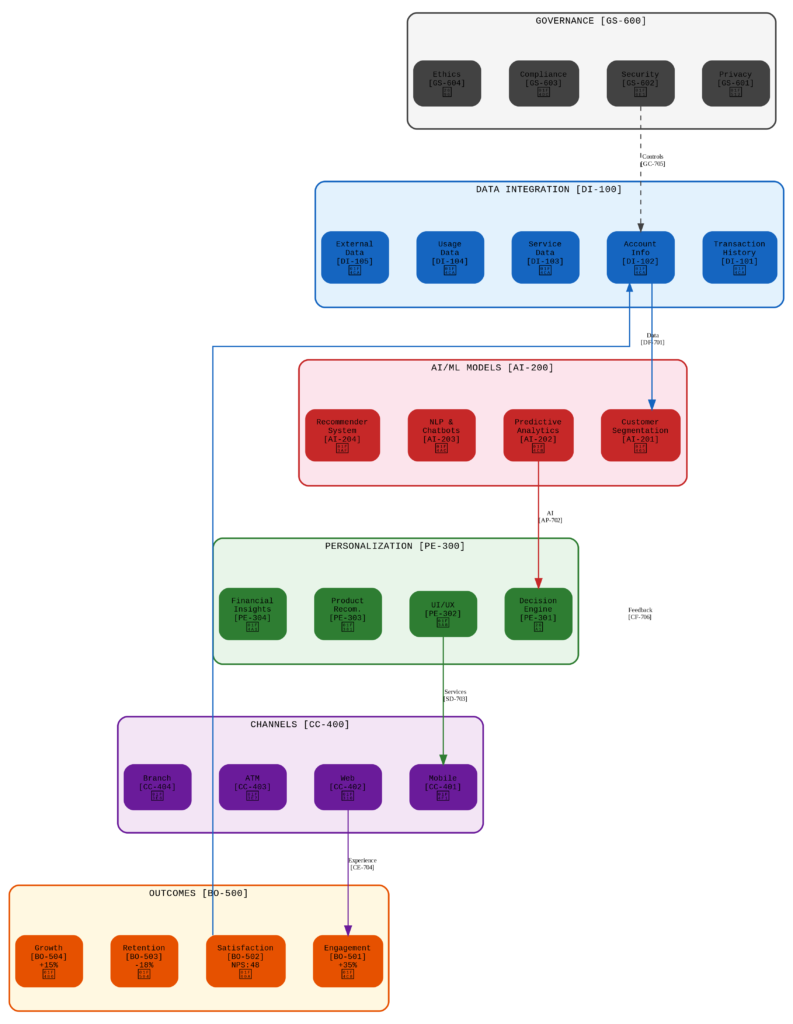Digital Transformation:
AI Solutions for Next-Generation Digital Banking
Table Of Contents
Key Components
Use Case
Results
Best Practices
Conclusion
Let’s dive into an AI/ML solution for Digital Transformation in Financial Services and Banking Companies, focusing on creating a personalized digital banking experience. In order to possess an AI-powered Personalized Digital Banking Platform G.AI.N Education train you how to leverage AI and ML to create a highly personalized digital banking experience, improving customer engagement, satisfaction, and ultimately, retention and profitability.
Key Components:
- Data Integration Layer: Aggregates data from various sources:
- Transaction history
- Account information
- Customer service interactions
- Mobile and web app usage data
- External data (e.g., credit scores, market trends)
- AI/ML Models:
- Customer Segmentation: Uses clustering algorithms (e.g., K-means, DBSCAN) to group customers based on behavior, preferences, and financial profiles.
- Predictive Analytics: Employs machine learning models (e.g., Random Forests, Gradient Boosting) to predict:
- Customer churn risk
- Product propensity
- Lifetime value
- Natural Language Processing (NLP): Implements NLP models for: 1) Sentiment analysis of customer interactions. 2) Chatbot and virtual assistant functionality
- Recommender System: Utilizes collaborative filtering and content-based algorithms to suggest personalized financial products and services.
- Real-time Decision Engine:
- Processes incoming customer interactions in real-time
- Applies AI models to make instant personalization decisions
- Personalization Layer:
- Customizes user interfaces based on individual preferences and behavior
- Tailors product recommendations and financial advice
- Omnichannel Integration: Ensures consistent personalized experience across web, mobile, ATM, and in-branch channels
- Privacy and Security Module:
- Implements robust data encryption and access controls
- Ensures compliance with data protection regulations (e.g., GDPR, CCPA)
- Continuous Learning and Optimization:
- Implements A/B testing for new features and recommendations
- Utilizes reinforcement learning to optimize long-term customer engagement
Use Case:
Suppose your NextGen Bank, a mid-sized retail bank, was losing market share to fintech competitors due to its outdated digital services. The bank decided to implement an AI-powered personalized digital banking platform to revitalize its services and improve customer retention. In this situation we coach and train your team to:
- Data Integration:
- Consolidated data from core banking systems, CRM, and digital channels
- Partnered with a data provider to enrich customer profiles with external data
- AI/ML Models:
- Developed customer segmentation model, identifying 8 distinct customer personas
- Created predictive models for churn risk and product propensity
- Implemented an NLP-powered chatbot for customer service
- Developed a recommender system for personalized product suggestions
- Personalization:
- Customized app interfaces based on user segment and behavior
- Implemented personalized financial insights and advice
- Tailored marketing communications to individual preferences
- Omnichannel Integration:
- Ensured consistent experience across mobile app, website, and ATMs
- Provided branch staff with AI-generated customer insights for in-person interactions
Results (After 12 months)
- Customer Engagement: 35% increase in mobile app usage
- 28% increase in product adoption rate
- Customer Satisfaction: Net Promoter Score (NPS) improved from 22 to 48
- 42% reduction in customer service call volume due to effective chatbot integration
- Financial Impact: 18% reduction in customer churn rate
- 22% increase in cross-selling success rate
- 15% growth in overall revenue
- Operational Efficiency: 30% reduction in time spent on routine customer inquiries
- 25% improvement in marketing campaign ROI due to better targeting
Base on our experience, financial institutions can effectively leverage AI and ML to drive digital transformation, enhancing customer experiences while managing risks and maintaining trust. The best practices are:
- Data Quality and Governance: a) Implement robust data cleaning and validation processes. b) Establish clear data governance policies to ensure data integrity and compliance
- Ethical AI: a) Develop AI models with fairness in mind, avoiding biases in recommendations or decisions. b) Regularly audit AI models for potential biases or unfair outcomes
- Transparency: a) Clearly communicate to customers how their data is being used to personalize services. b) Provide options for customers to opt out of data-driven personalization if desired.
- Continuous Learning: a) Regularly retrain models with new data to maintain accuracy and relevance. b) Implement feedback loops to continuously improve personalization algorithms.
- Security and Privacy: a) Implement state-of-the-art security measures to protect sensitive financial data. b) Ensure compliance with all relevant data protection regulations.
- Phased Implementation: 1) Start with pilot programs to test and refine the system before full-scale deployment. b) Gradually introduce new features to allow for user adaptation and feedback.
- Cross-functional Collaboration: a) Foster collaboration between data science, IT, marketing, and customer service teams. b) Ensure alignment between AI initiatives and overall business strategy.
- Customer Education: a) Provide clear explanations of new AI-driven features to customers. b) Offer tutorials and support to help customers make the most of personalized services.
- Performance Monitoring: a) Implement comprehensive monitoring of system performance and user engagement. b) Regularly review KPIs and adjust strategies as needed.
- Human Oversight: a) Maintain human oversight of AI systems, especially for high-stakes decisions. b) Provide channels for human intervention when AI recommendations are questioned.
Conclusion:
The implementation of AI and machine learning in digital banking represents a pivotal shift in how financial institutions serve their customers and compete in an increasingly digital marketplace. As demonstrated by NextGen Bank’s successful transformation, the strategic integration of AI/ML technologies can deliver remarkable improvements across multiple dimensions: from a 35% increase in mobile app engagement to an 18% reduction in customer churn, while simultaneously driving a 15% growth in overall revenue.
AI-powered personalization is no longer a luxury but a fundamental requirement for financial institutions aiming to remain competitive in the digital age. The comprehensive approach – combining sophisticated data integration, advanced AI/ML models, and careful attention to privacy and security – creates a framework that can transform traditional banking operations into dynamic, customer-centric digital experiences.
However, the success of such initiatives hinges on more than just technological implementation. The best practices outlined demonstrate that successful AI transformation requires a delicate balance of technical expertise, ethical considerations, and human-centered design. Financial institutions must maintain robust data governance, ensure algorithmic fairness, and prioritize transparency while continuously adapting to evolving customer needs and regulatory requirements.
Looking ahead, the future of AI in banking will likely see even more sophisticated applications, potentially incorporating emerging technologies like federated learning for enhanced privacy, advanced natural language processing for more nuanced customer interactions, and reinforcement learning for more dynamic personalization. However, the fundamental principles of maintaining customer trust, ensuring data security, and delivering tangible value will remain paramount.

Meet Our Lead Instructors
Lorem ipsum dolor sit amet, consectetur adipiscing elit. Duis ac eros ut dui bibendum ultricies. Maecenas egestas fringilla semper.




Number Speaks
10+
Awards
5+
Countries
12+
Partners
7K+
Students
What Our Students Have to Say




